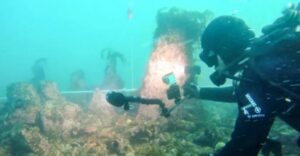An assault on the beach Agia Marina Rhodes was carried out today by a team of executives of the land service and the port authority, in order to establish any violations on the beach and the beach.
During the inspection it was found the installation of illegal structures (19 metal structures) in the sea, as well as violations on the beach.
A similar violation was found last year, on the same beach and by the same company, and immediately the competent authorities proceeded to issue protocols for their demolition.
The same is going to happen this year along with the corresponding strict administrative measures, applying the relevant law that was recently passed and provides for specific rules for the operation of businesses on the beach and beaches.
rodos
The operation was carried out under the coordination of DG Public Property N. Kollias with both the competent department of the Ministry of Shipping and the Port Authority of Rhodes and the local land services.
“When we say that order is being brought to the seashore and beaches we mean it! Those who break the law on the beaches will find us against them,” said Minister of National Economy and Finance Kostis Hatzidakis.
“In every incident of illegality we will be met with speed and determination. We have our allies the citizens but also modern technologies, such as the use of drones and the new myCoast application that allow us to intervene immediately where necessary,” Hatzidakis added.
Rain of complaints on myCoast
Complaints about violations and encroachments on beaches across the country on the special myCoast application are increasing day by day.
The online platform has received more than 1,900 complaints to date, with the largest number of complaints in the Cyclades, the Dodecanese and Halkidiki, where the onslaught of drone surveillance has recently begun!
The clearing and verification of all these complaints will start after the completion of the e-auction process. The relevant deadline was extended until 28 June in order to gradually complete the remaining pending auctions.
According to data from the Ministry of Economy and Finance, 80% of the scheduled auctions have been posted and completed. And the direct contracts of adjacent businesses, hotels receiving direct leases without an auction are expected to be completed within 10days.
To date, 959 auctions have been posted on the platform, with the total number expected to exceed 1,200 this year. Of the 959 auctions, 735 have been completed with the award of the beach to those companies that paid the highest price, while the rest have been deemed barren and are scheduled to be re-auctioned in the coming period.
At the same time, there are 6,500 active contracts which do not need to be re-auctioned until the end of their lease period, but are subject to the same rules on penalties and fines as the new concessions.
How the “blockades” are set up
According to the circular of the new guidelines, signed by Mr. Hatzidakis himself, compliance with the terms of the concession contracts in areas of the seashore, beach, bank, riparian zone, etc. is checked in the following ways:
By autopsy in the area of the seashore and the beach, by mixed teams and joint control teams, executives of the Ministry of National Economy and Finance, the Real Estate Service, the municipality, the ADSE, the Economic Police, the ELAS and the prosecuting authorities. After the autopsy has been carried out, an on-site conclusion – autopsy report with accompanying photographic material, where possible, is drawn up and delivered or affixed immediately.
Remote photographic observation of the coastal and beach area, in particular by unmanned aerial vehicles, operating autonomously or remotely (remote sensing) in the air or using satellite imagery. We have already seen the first photographs taken by drones in Halkidiki, after a “rain” of complaints. The Land Service receives the photographic supporting material and on the basis of this it draws up the findings – autopsy reports, taking the prescribed administrative measures and imposing sanctions described by law.
Step by step the complaint through “MyCoast”
The “MyCoast” application is available free of charge for mobile devices, such as mobile phones and tablets, via the App Store, soon also via the Play Store. The steps for citizens to follow are as follows:
– They open the app and activate their mobile GPS.
– They locate their area of interest on the map and the concession polygon appears on the screen of their device.
– Selecting the polygon displays its details, i.e. location, start and end of the concession, usage, area, etc.
– In case they find arbitrary occupation of an area or obstruction of free access, they can submit the aforementioned complaints via the app
– Identify the reason for the complaint and enter a brief description of the problem.
Complaints can be submitted both anonymously and anonymously. In the case of an anonymous complaint, citizens are required to log in to the application with personal TaxisNet passwords to complete the process.
Please note that a complaint can only be submitted via a mobile device located near the point of the concession in question. In addition, only one complaint, per type of complaint, can be submitted on the same day from the same device and for the same concession.
Upon successful submission of the named complaint, the application displays the unique number and date of submission. Citizens are only able to browse the history of their named complaints and their details, such as the status of the complaint.
The submitted complaints are displayed in the subsystem “Register of Concessions for Simple Use of Beaches and Beaches” of the Ministry of National Economy and Finance, so that they can be examined by the competent Land Services.
In case it is not possible to complete the complaint through “MyCoast”, citizens can make it by any appropriate means before any public authority, which is obliged to forward it on the same day to the competent Land Service of the Ministry of National Economy and Finance.
Gov.gr wallet: Real estate, insurance data, and even pets on your mobile
The fines
From 2,000 euros to 60,000 euros are the fines imposed for obstructing free public access to the sea, the seashore and the beach. More specifically:
– For placing structures such as buildings, walls, fences of all types, a fine of 500 euros per cubic meter corresponding to the volume of the structure is imposed. If the removal of movable elements requires the use of mechanical equipment, this fine shall be quadrupled.
– For movable elements that cannot be easily moved such as cars, motorcycles, heavy vehicles, tents, a fine of EUR 500 per metre corresponding to the width of the passage obstructed shall be imposed. If the removal of movable objects requires the use of mechanical equipment, a fine of EUR 500 per cubic metre corresponding to the volume of the objects obstructing the passage shall be imposed.
– For the throwing of rubble, building materials and all types of waste at public crossing points to the sea, a fine of EUR 500 per metre corresponding to the width of the crossing obstructed (double if the removal of the movable items requires the use of mechanical equipment).
– For any kind of activity or event, whether individual or collective, professional or not, permanent or temporary, which obstructs direct public access to the sea, EUR 500 per metre corresponding to the width of the passage obstructed.
– For any kind of physical or verbal obstruction, a fine of EUR 2 000.
The fines may not be less than EUR 2,000 or more than EUR 60,000.
Ask me anything
Explore related questions





